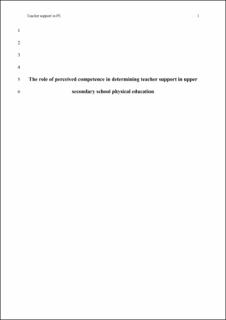| dc.contributor.author | Laxdal, Aron Gauti | |
| dc.contributor.author | Johannsson, Erlingur | |
| dc.contributor.author | Giske, Rune | |
| dc.coverage.spatial | Iceland | en_US |
| dc.date.accessioned | 2020-09-04T10:59:12Z | |
| dc.date.available | 2020-09-04T10:59:12Z | |
| dc.date.created | 2020-06-30T13:37:08Z | |
| dc.date.issued | 2020 | |
| dc.identifier.citation | Laxdal, A., Johannsson, E., & Giske, R. (2020). The role of perceived competence in determining teacher support in upper secondary school physical education. The Physical Educator, 77(2), 384–403. | en_US |
| dc.identifier.issn | 0031-8981 | |
| dc.identifier.uri | https://hdl.handle.net/11250/2676407 | |
| dc.description | Accepted manuscript. Available 20 Feb 2021. | en_US |
| dc.description.abstract | Physical education remains one of the most liked school subjects, irrespective of grade level or geography. Nevertheless, sections of the student body dislike the subject immensely and even more think it should be organized differently. Students who are less competent have long claimed that physical education teachers and the curriculum favor the competent. Despite clear refusals of any conscious favoritism from the teachers, perceived competence is one of the premier predictors of students liking and being motivated to participate in the subject, the other being participation in organized sport. The purpose of this study was therefore to refute or confirm the veracity of the aforementioned claims through an investigation of the relationship between perceived competence and teacher-dependent support in upper secondary school physical education. One thousand one hundred thirty-three upper secondary school students (Mage = 17.2, SD = 0.86) from Norway (n = 554) and Iceland (n = 579) participated in a cross-sectional survey. Four teacher-dependent support variables were measured via self-reporting: perceived competence support, perceived relatedness support, perceived autonomy support, and perceived teacher learning support. To simplify comparison between groups, we divided the sample into three units: highly competent students, moderately competent students, and less competent students. A one-way multivariate analysis of covariance (MANCOVA), with gender as a covariate, found indications of biased teacher behavior, thus supporting the aforementioned accusations. Even though some discrepancies may exist between the reported and actual support levels, students respond and react in accordance with their perceptions, which is why their perceptions are of concern. These findings are incongruent with the aims of the subject and indicate that modified practices are needed if a more equal learning environment for all students is desired. To reverse the current trend, we provide three measures that we believe can reduce the aforementioned discrepancy. First, PE teachers must become more aware of their own biases, recognizing their tendency to treat the competent more favorably. Second, challenges related to the students who show less appreciation for the subject should become more prominent in physical education teacher education. Finally, the advantage of those who participate in leisuretime sporting activities, over those who do not, should be reduced through a reevaluation of the current curricular implementation. | en_US |
| dc.language.iso | eng | en_US |
| dc.publisher | Sagamore | en_US |
| dc.subject | basic psychological needs | en_US |
| dc.subject | high school | en_US |
| dc.subject | self-determination theory | en_US |
| dc.subject | teacher bias | en_US |
| dc.title | The Role of Perceived Competence in Determining Teacher Support in Upper Secondary School Physical Education | en_US |
| dc.type | Peer reviewed | en_US |
| dc.type | Journal article | en_US |
| dc.description.version | acceptedVersion | en_US |
| dc.subject.nsi | VDP::Samfunnsvitenskap: 200::Pedagogiske fag: 280::Fagdidaktikk: 283 | en_US |
| dc.source.pagenumber | 384–403 | en_US |
| dc.source.volume | 77 | en_US |
| dc.source.journal | The Physical Educator | en_US |
| dc.source.issue | 2 | en_US |
| dc.identifier.doi | 10.18666/TPE-2020-V77-I2-9606 | |
| dc.identifier.cristin | 1817835 | |
| cristin.ispublished | true | |
| cristin.fulltext | postprint | |
| cristin.qualitycode | 1 | |
